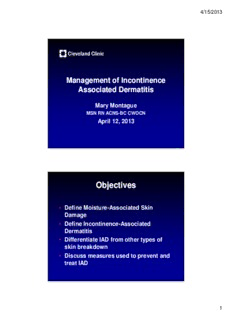
MSN RN ACNS-BC CWOCN - Cleveland Clinic PDF
Preview MSN RN ACNS-BC CWOCN - Cleveland Clinic
4/15/2013 MMaannaaggeemmeenntt ooff IInnccoonnttiinneennccee AAssssoocciiaatteedd DDeerrmmaattiittiiss Mary Montague MSN RN ACNS-BC CWOCN April 12, 2013 OObbjjeeccttiivveess • Define Moisture-Associated Skin Damage • Define Incontinence-Associated Dermatitis • Differentiate IAD from other types of skin breakdown • Discuss measures used to prevent and treat IAD 1 4/15/2013 OOnnccee uuppoonn aa ttiimmee ((22000055))…….... • A group of esteemed WOCN colleagues met to focus attention on the issue of incontinence-associated dermatitis • Existing research was defined and gaps in clinical evidence were identified • The term “Incontinence-Associated ” Dermatitis (IAD) was advocated FFiinnddiinnggss ppuubblliisshheedd iinn 22000077 • IAD is a common problem, however there was little evidence concerning its epidemiology, etiology, or pathophysiology • More research was needed to determine the efficacy and effectiveness of IAD interventions • A tool to identify IAD and measure its severity in both the clinical and research setting was needed 2 4/15/2013 OOnnccee uuppoonn aannootthheerr ttiimmee ((22001100)).................. • Another group of esteemed WOCN colleagues met to increase the attention of skin damage caused by moisture • 3 articles were published in 2011 enhancing the knowledge of various forms of moisture damage MMooiissttuurree--AAssssoocciiaatteedd SSkkiinn DDaammaaggee ((MMAASSDD)) • Inflammation and erosion of the skin caused by prolonged exposure to various sources of moisture, including urine or stool, perspiration, wound exudate, effluent from ostomy, mucus, or saliva • Exposure alone not sufficient to produce skin damage • MASD based on chemical content of moisture, force of friction, and presence of potential pathogenic microorganisms 3 4/15/2013 TTyyppeess ooff MMAADDSS • Incontinent-associated dermatitis (IAD) • Intertriginous dermatitis • Periwound moisture-associated dermatitis • Peristomal moisture-associated dermatitis IInnccoonnttiinneennccee--AAssssoocciiaatteedd DDeerrmmaattiittiiss ((IIAADD)) 4 4/15/2013 DDeeffiinniittiioonn • Inflammation of the skin as a result of chronic or repeated exposure to urine or fecal matter and manifests as redness with or without blistering and skin erosion. • IAD is now the accepted term for skin damage caused by exposure to urine or stool Incontinence Associated Dermatitis (IAD): Best Practice for Clinicians WOCN Society, 2011 IIAADD • Occasional exposure to urine may not be harmful, but repeated exposure in presence of occlusion or fecal material puts skin at higher risk • Top-down skin injury, originating on the skin surface and progressing to upper dermis 5 4/15/2013 DDiissttrriibbuuttiioonn ooff SSkkiinn DDaammaaggee Urine Stool • Perineum (skin from • Perianal area vulva to anus in • Gluteal cleft women; skin from scrotum to anus in men) • Inner, posterior • Labial folds thighs, depending • Groin on exposure • Buttocks • Scrotum EEffffeeccttss ooff UUrriinnee • Overhydration of skin • Increase in skin pH • Increased friction as skin moves against absorptive devices, clothing, or bedding • Decreased tissue tolerance as a result of friction, shear, or pressure 6 4/15/2013 EEffffeeccttss ooff SSttooooll • Lipases and proteases produced by fecal bacteria break down protein in kerotinocytes, contributing to skin erosion • When urine and stool mix, bacteria in stool converts urea to ammonia • Ammonia increases pH of skin, destroying the acid mantle • This disruption initiates the release of inflammatory cytokines and histamines EEffffeeccttss ooff LLiiqquuiidd SSttooooll • Liquid stool more irritating than solid stool because it encompasses a larger skin surface area • Contains more bile salts and pancreatic lipases, which are irritating to skin 7 4/15/2013 OOtthheerr EEffffeeccttss • Common secondary infections can develop from Candida albicans or toxins from C difficile FFaaccttoorrss CCoonnttrriibbuuttiinngg ttoo IIAADD • Tissue Tolerance • Perineal Environment • Toileting Ability 8 4/15/2013 TTiissssuuee TToolleerraannccee • Age • Health status • Nutritional status • Oxygenation • Perfusion • Exposure to shear or friction • Core body temperature • Presence of other irritants or allergens • Use of occlusive containment devices PPeerriinneeaall EEnnvviirroonnmmeenntt • Altered by - Frequency of incontinence - Type of incontinence (urinary, fecal, or both) - Condition of skin (inflamed or edematous) - Factors that impair perineal skin (hydration, pH of urine or stool, pathogens in stool or on skin) 9 4/15/2013 TTooiilleettiinngg AAbbiilliittyy • Physical ability to reach toilet • Cognitive inability to recognize need for toilet MMiilldd IIAADD 10
Description: